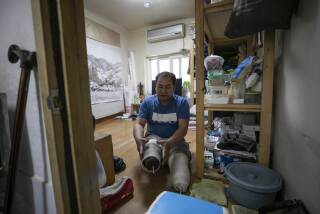Iran earthquake toll rises to more than 300
TEHRAN — Iranians turned their efforts from rescue to relief Sunday after twin earthquakes that killed more than 300 people, trying to provide medical care for more than 2,000 injured and shelter and aid for thousands left homeless.
For a second night in a row, survivors of Saturday’s magnitude 6.4 and 6.3 quakes in a northwestern province were advised to sleep outside for fear of continuing tremors. Bulldozers were already at work starting to clear up the rubble left from several destroyed villages.
“Official rescues halted or seem to have stopped, as there is no hope of any alive to be unearthed, and the number of Red Crescent rescue team is not big enough and few of them are trained enough,” said one resident in the town of Varzaqan. .
The quakes hit in a sparsely populated region, but entire villages were sent crumbling to the ground. Many others were partially damaged.
Despite the relatively small population of the region, Naser Zagar, who heads the coroner’s office in the town of Ahar, near the two epicenters, toldIran’sofficial Islamic Republic News Agency on Saturday that the death count could be more than 1,000.
The mayor of Varzaqan, one of the hardest-hit towns, said 12 villages in the region had been destroyed. Each of those villages had up to 1,000 residents and as many as a third of those people may have been killed, he told the news service.
Many of the dead were women and children killed under the rubble of falling homes as the quakes struck 11 minutes apart in late afternoon, a time when most men were still outdoors working in this agricultural region.
“Due to the traditional architecture of the villages, using clay bricks mixed with straw, rural areas have sustained most of the damage,” said Reza Sedighi, Ahar’s governor and head of the disaster relief center. He estimated that 25% of the public places, administrative buildings and houses were damaged.
The food and canned products delivered to Ahar so far have been insufficient and the area is in desperate need of water, dried food and canned goods, he said.
“People need tents and blankets as the weather is cold at night and they have to sleep under they sky, anticipating more tremors,” said Majan Laghaie, a reporter for the independent Shargh newspaper. “We visited many villages, five of them entirely heaps of rubble and debris.... People are shocked and still anticipating more tremors.”
Ayatollah Shabestari, the provincial representative of Iran’ssupreme leader, Ayatollah Ali Khamenei, called for two days of mourning.
There was early criticism of the government’s response to the disaster, even as President Mahmoud Ahmadinejad’s Cabinet members sent their official condolences to the people of East Azerbaijan province.
On Saturday, as the nascent stages of rescue efforts were still underway, Turkish separatists in the region called an opposition TV station and complained of the slow response. They appealed to the governments of neighboring Turkey and Azerbaijan to send aid.
Iran has a deadly history of earthquakes. In 2003, more than 25,000 people were killed when a magnitude 6.6 quake struck the southeast part of the country.
“Nowhere in the world does a 6 Richter scale earthquake kill so many people,” Iran’s leading seismologist, Bahram Akasheh, told a local news agency Sunday. “The maximum number of the casualties should have been 10 injured. Due to the inappropriate constructions, our cities and villages are heavily damaged. It shows our crisis management has failed to strengthen the foundation of buildings.
“We have predicted an over-7 Richter earthquake in the central or eastern ... mountain ranges,” Akasheh said. “We should for sure anticipate for it in the future.”
A former member of parliament, Gholamali Masoudi Rayhan, told the semiofficial Iranian Labor News Agency that there were also problems in how state media were covering the disaster.
“If Iranian state-run TV covered the earthquakes better, domestic and even foreign relief would be delivered more smoothly to the quake-stricken areas,” he said.
Mostaghim is a special correspondent.
More to Read
Start your day right
Sign up for Essential California for news, features and recommendations from the L.A. Times and beyond in your inbox six days a week.
You may occasionally receive promotional content from the Los Angeles Times.






